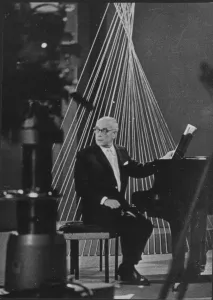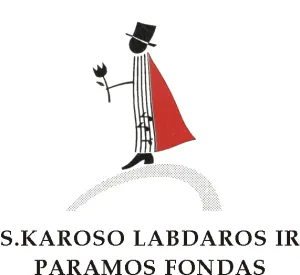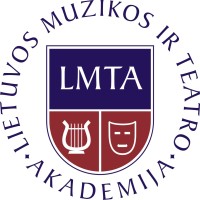AND REDIRECTED TO MIRROR SERVER.
IF YOU ARE NOT BOT PLEASE VERIFY YOUR BROWSER IDENTIFICATION:
Mozilla/5.0 AppleWebKit/537.36 (KHTML, like Gecko; compatible; ClaudeBot/1.0; +claudebot@anthropic.com)
Stasys Vainiūnas – a personality that contained the talents of a performer, a creator, and a pedagogue all at once. Being a professional pianist, actively performing on the stage, he expressed himself as a soloist and a member of chamber ensembles, while often playing his own creations as well. During the active part of his life, he also worked as a grand piano professor at the Lithuanian Academy of Music and Theatre and was the head of the grand piano department as well.
The artistic personality of Stasys Vainiūnas matured in shifting ideological and stylistic contexts. The first significant opus of this composer – “The Little Insects Suite” for the grand piano – was created in the 1940s, which marked the beginning of new and fundamental political changes in Lithuania: a Soviet occupation, then a German occupation, and the Soviet occupation again. Soon this composer, whose creative experience was still light, was destined to become one of the brightest stars on the Lithuanian stage in the post-war period.
Stasys Vainiūnas and his contemporaries
Usually, this composer and pianist is mentioned in the same breath as two other Lithuanian composers, almost identical in age – Balys Dvarionas (1904–1972) and Antanas Račiūnas (1905–1984). And even though each of them had their own creative momentum, different values impacted their musical orientation, and their priorities diverged when it came to genres, due to the particular situation that presented itself during the post-war period they often were identified as a single “group”, which back in the day was nicknamed „DaRaVa“.
In 1944, when the second Soviet occupation started, the situation for artists in Lithuania changed significantly, along with the stylistic and social context of musical creations. The occupation destroyed the natural development of Lithuanian music and new leaders arose in the face of change: Antanas Račiūnas made his debut in the 30s in the field of large works, he was a student of Juozas Gruodis (1884–1948); Balys Dvarionas, who was just dabbing in composition, but at the same time had already established himself as an accomplished pianist and conductor; and a pianist, organist, and composer Stasys Vainiūnas – A Lithuanian from Riga, an alumnus of the Conservatory of Riga, who had lived in the capital city of Latvia until 1938.

Vainiūnas the pianist
Having moved to Lithuania, Vainiūnas took up the work of a grand piano teacher, yet he had already managed to make a name for himself as a virtuoso pianist. That title was earned due to frequently played recitals in Latvia, and Lithuania, as well as concerts as a pianist that earned critical acclaim – in 1933 he became a laureate at The International Singer and Pianist Competition in Vienna; 1935–1936 m. he honed his skills at the Vienna academy of Music, improving his grand piano prowess under the tutelage of prof. Emil von Sauer and occasionally adding to his composing skills under Eduard Steuermann.
Thus, the aesthetic and artistic taste of Vainiūnas during his younger years was formed by the atmosphere of two different cultural centres – Riga and Vienna. The grand piano repertoire he chose to perform moulded him as well, significantly influenced not only by romantic music, but also by the works of impressionists. All this helped develop and mature the creative experience of Vainiūnas, and as a result, his music, albeit not directly connected to any modern techniques, always managed to remain “literate”, proud, untouched by sentimentality, not overloaded with sensitivity or the shadows of lyrical literal programmes. It oozes with poise, the experiences of the urban man, and universal meanings. All this is confirmed by the coherent evolution of the stylistics of Vainiūnas’s creation, his complex musical language and the spiritual experiences contemplated within pure musical forms. The latter becomes especially true in his later works, visible in the pain and dramatism entombed within them.
Vainiūnas the composer
The road of the composer for Stasys Vainiūnas began in 1940, with the “Little Insects Suite”. The first wave of creative intensity, where his own creations undoubtedly overwhelmed his activity as a pianist, matched the grim reality of the occupied post-war Lithuania, where artistic life became characterised by the style of social realism, propagated by partisan ideologues of the time, that required a romantic style of music, based on quotes from folk songs, and a certain overly optimistic pathos. The main guidelines for official artistic creation came out to be “the Party”, “the People”, and “the Masses”.
At the time, Vainiūnas created his big partitures – one after another: Trio for the grand piano, the first concert for a grand piano and an orchestra (1945), and Rhapsody for two grand pianos and an orchestra (1947) – in there we can find stylistic colourfulness, a romanticism-based mind-set, melodies from folk songs, appearing in their natural forms, pattern-based templates. Nonetheless, the early success of these compositions was soon clouded: with the Soviet ideological dictate pushing his roots deeper and deeper into society, threatening complaints came towards composers in crashing waves – they were blamed for being too formal, excessively intellectual. Stasys Vainiūnas also received his share of criticism, mostly for the Rhapsody – a creation of individual style, marked with shades of nationalism, showing no lack of dissonance or polyphonic structures.
Being labelled as a “formalist” have sealed the fate of other early works by Vainiūnas as well. Only the Trio was given a chance to be played more often, while the Concert and the Rhapsody were banned from concert stages for a very long time. In the early 50s the skies became a little clearer, the tension subsided, Vainiūnas’s music received some recognition again, albeit still being deemed as having “harmful tendencies” – such as lack of heroism and a larger-than-preferred fascination with multipart songs – and that kept up for a while. Regardless, even in these dramatic times, the composer stayed true to his creative principles. Under ideological pressure, yet making the slightest compromises, he managed to maintain creative pride, meanwhile his stylistics slowly evolved as he progressed through life, they spanned with unique attitude and style. That is particularly noticeable in his instrumental works.
Creative heritage
Vainiūnas’s musical heritage is obviously dominated by the timbre of the grand piano – that is justified not only by solo compositions, but chamber ensembles and concert opuses as well: four concerts for the grand piano and an orchestra, solo cycles, and separate miniatures, two grand-piano quintets, “Music” for two grand pianos and a string quartet. The individual style of this composer was touched by tendencies of romanticism and impressionism, which interacted with the Lithuanian musical folklore. Even though the composer deliberately did not use modern composing systems of the 20th century, he was not in opposition to musical innovations and took a regular interest in them. In his creations, a lot of attention is paid to rhythmic and harmonic mastery. Later opuses by the composer are characterised by extended (12-note) tonality, polytonality, complex interval-chord structures, manifestations of modality and sonorism. It is also apparent that Stasys Vainiūnas remained consistent throughout his career, making his music always recognisable, as it is based on firm structural principles and a characteristic set of individual traits. Among them – echoes from multipart songs, lively pulse, formed via accentual irregularities, and a propensity to improvise.
Several aspects give life to Vainiūnas’s body of work today. First of all, his long-lasting experience as a grand piano teacher, led to his music finding its way into the repertoires of his students. Second, it was given vitality by his two daughters, both active musicians – pianist Birutė Vainiūnaitė and violinist Audronė Vainiūnaitė. Finally, the Stasys Vainiūnas Competition for Pianists is being held every two years since 1965. In 1993 it became international, and since 2006 added a category for chamber ensembles as well. All these aspects just serve to prove that initiative from performers themselves, as well as the nature of the music being favourable to concerts, were crucial aspects that aided the dissemination of the works of Stasys Vainiūnas.
© Vytautė Markeliūnienė
Lietuvos muzikos link No. 17
Main Supporters



Organizers

Member of

Partners


 Lietuvių
Lietuvių
 Русский
Русский